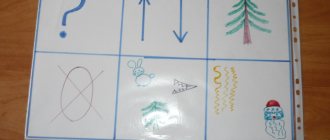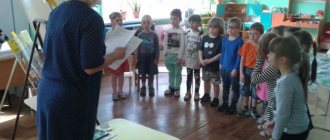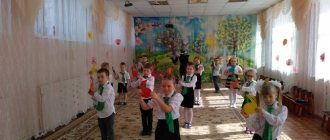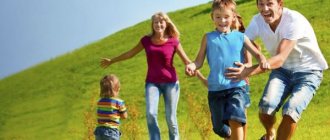LiveInternetLiveInternet
Quote from Hugo_Pugo_handicrafts message
Read in full In your quotation book or community!
The structure of classes for vocabulary development in preschool children
Someday I plan to take my daughter to a development center for preschool children. And now I’m looking through similar sites, comparing prices, conditions, list of services. The last place I was was “Umka” - a developmental children's center, which, in addition to a huge range of services, also offers dancing for children in Marino... At first glance, the impression of the site and this center remains favorable...
And now directly on the topic of this post. The presented material is a delicacy for preschool teachers (educators). I have never yet come across a textbook or training manual where the generalized structure of various classes on speech development for preschoolers was described in such detail and in an accessible way. Thanks to the one who processed and systematized the material in such a way.
Table 1
Structure of classes on vocabulary development in preschool children (compiled according to Sokhin F.A.)
| Classes on examining objects (toys) | Painting viewing activities | Classes to familiarize yourself with the qualities and properties of objects | Comparison exercises | Lessons on the formation of general concepts | Classes for teaching children to solve riddles. | |
| 1 | 2 | 3 | 4 | 5 | 6 | 7 |
| General | The abstract is prepared traditionally In one lesson, several vocabulary problems can be solved at once - we learn some words for the first time = expansion of the dictionary, introduce some words into children’s speech = activate the dictionary, clarify and consolidate some... | |||||
| Guidelines | Up to the senior group, 1, rarely 2 subjects are covered in class; starting from the senior group, 2 or more subjects are covered at the same time. If the subject(s) are being considered for the first time, then we take less details, details, and clarifications for consideration, and consider the most general, striking points. | You can examine different paintings - subject, subject, landscapes. And so on. Up to the senior group, 1, rarely 2 paintings are considered in class; starting from the senior group, 2 or more paintings are considered at the same time. If the picture is being examined for the first time, then we take fewer details, details, clarifications for consideration, and consider the most general, striking points. | Up to the senior group, 1, rarely 2 subjects are covered in class; starting from the senior group, 2 or more subjects are covered at the same time. It is assumed that this lesson will cover subjects that have already been taught. | Before the senior group, 2 subjects are considered in class; starting from the senior group, 2 or more subjects are considered simultaneously. It is assumed that this lesson will cover subjects that have already been taught. It is necessary to pay special attention to the selection of objects that will be considered in the lesson - there should be many characteristics available for comparison by children (color, shape, size, parts, details. Purpose, material, etc.) These should be similar objects that can be confused ( briefcase bag, Panama cap, magazine-book, etc.) | In the preparatory group, children should be able to freely name 30-40 generalizing concepts (see program) Before the senior group, 1 generalizing concept is introduced in the lesson; after the senior group, 1 new generalizing concept can be introduced in one lesson and then compare it with the already learned generalizing concept. For the older group, to compare 2 generalizing concepts, you must first conduct a lesson on one generalizing concept, then conduct a lesson on another generalizing concept, then a lesson on comparing these generalizing concepts. This type of lesson can be conducted to familiarize and compare two different general concepts (animals - birds) and to clarify an already studied general concept (animals - wild, domestic, predatory, northern, etc.) | |
| Part 1 (introductory). | Traditional (see lecture on class notes) - Organizing time — Interesting/surprise moment — Setting goals for children’s activities/motivation. — Unfolding the plot of the lesson, the surprise appearance of the subject | Traditional (see lecture on class notes) - Organizing time — Interesting/surprise moment — Setting goals for children’s activities/motivation. — Expanding the plot of the lesson, the surprise appearance of the picture | Traditional (see lecture on class notes) - Organizing time — Interesting/surprise moment — Setting goals for children’s activities/motivation. — Unfolding the plot of the lesson, the surprise appearance of the subject | Traditional (see lecture on class notes) - Organizing time — Interesting/surprise moment — Setting goals for children’s activities/motivation. — Unfolding the plot of the lesson, the surprise appearance of the subject | Traditional (see lecture on class notes) - Organizing time — Interesting/surprise moment — Setting goals for children’s activities/motivation. — Unfolding the plot of the lesson, the surprise appearance of the subject | Traditional (see lecture on class notes) - Organizing time — Interesting/surprise moment — Setting goals for children’s activities/motivation. — Unfolding the plot of the lesson, the surprise appearance of the subject |
| Part 2 (main). | 1. Examination of the subject. At this time, the teacher describes the subject, repeatedly naming those qualities of the subject that are planned for study in the program content Do not forget to return to the plot of the entire lesson or to the motive created for this task, assessing the children’s activities. | 1.Looking at the picture. At this time, the teacher describes the picture, repeatedly naming those words that are planned for study in the program content Do not forget to return to the plot of the entire lesson or to the motive created for this task, assessing the children’s activities. | 1. Consideration of 2 or more subjects and completion of tasks (experiments) of the teacher that affect exactly those properties of the subject that are planned for study in the program content. Do not forget to return to the plot of the entire lesson or to the motive created for this task, assessing the children’s activities. | 1. Examination of objects (short-term, until children lose interest in them). | 1. Examination of objects or pictures (short-term, until children lose interest in them). Do not forget to return to the plot of the entire lesson or to the motive created for this task, assessing the children’s activities. | |
| 2. Questions for children based on what they just heard - the goal is to make children repeat those words that are planned for study in the program content Do not forget to return to the plot of the entire lesson or to the motive created for this task, assessing the children’s activities. | 2. Questions for children based on what they just heard - the goal is to make children repeat those words that are planned for study in the program content Do not forget to return to the plot of the entire lesson or to the motive created for this task, assessing the children’s activities. | 2. Question for the children - why is it possible to complete the teacher’s assignment with some subjects, but not with others. Children themselves give in their answer the name of the property that is planned to be studied in the program content. If the children cannot find the exact word, then the teacher introduces it. Do not forget to return to the plot of the entire lesson or to the motive created for this task, assessing the children’s activities. | 2. Children answer the teacher’s question - how these objects differ. The teacher listens to the children’s answers, corrects them or generalizes them (that is, repeats them in his own, more literate words). The teacher asks his questions in such a way that the children use the words planned in the program content in their answers and conducts vocabulary work on them (repetitions, etc.). Do not forget to return to the plot of the entire lesson or to the motive created for this task, assessing the children’s activities. | 2. Consideration of each of the presented subjects separately and questions about them. The teacher should ask questions to identify those signs by which these items will subsequently be classified into one general concept. There should be 3-5 signs in total. At the same time, we generalize the children’s answers (that is, we reformulate their answers in such a way that the children will then prove that these objects belong to one generalizing concept) Do not forget to return to the plot of the entire lesson or to the motive created for this task, assessing the children’s activities. | ||
| 3. Familiarization with the purpose of the item. The teacher names the main actions that can be performed using the object and (if possible) demonstrates them. We only talk about those actions that are planned for study in the program content Do not forget to return to the plot of the entire lesson or to the motive created for this task, assessing the children’s activities. | 3. Familiarization with the purpose or meaning of what is depicted in the picture. The teacher names the main actions depicted in the picture or that can be performed using the depicted object and (if possible) demonstrates them. We only talk about those actions that are planned for study in the program content Do not forget to return to the plot of the entire lesson or to the motive created for this task, assessing the children’s activities. | 3. Consolidation of a newly mastered concept - the teacher places additional objects (specially prepared) in front of the children, and the children show objects that have this property and those that do not have it, always explaining why they decided so (how they guessed). Do not forget to return to the plot of the entire lesson or to the motive created for this task, assessing the children’s activities. | 3. If the children have not listed all the differences, the teacher asks leading questions and the children highlight the remaining differences. As a rule, the teacher attracts children's attention to the details of objects and their purpose. The teacher asks his questions in such a way that the children use the words planned in the program content in their answers and conducts vocabulary work on them (repetitions, etc.). Do not forget to return to the plot of the entire lesson or to the motive created for this task, assessing the children’s activities. | 3. Questions for children - what is common in all these subjects. Children's answers should contain common features indicating that these objects belong to one general concept. (We already discussed this with the children at the beginning of the lesson, only 3-5 signs). Do not forget to return to the plot of the entire lesson or to the motive created for this task, assessing the children’s activities. | ||
| 4. Questions for children about the purpose of the subject (based on what they just heard) - the goal is to make children repeat those words that are planned for study in the program content Do not forget to return to the plot of the entire lesson or to the motive created for this task, assessing the children’s activities. | 4. Questions for children about what they just heard - the goal is to make children repeat those words that are planned for study in the program content Do not forget to return to the plot of the entire lesson or to the motive created for this task, assessing the children’s activities. | 4. Reinforcing already mastered examination actions with children - the teacher explains how (in what experience) one can find out whether this object has a given property or not, shows, and allows the children to independently carry out examination actions with objects. It is desirable that these be new items, and in large quantities - handouts for each child. Do not forget to return to the plot of the entire lesson or to the motive created for this task, assessing the children’s activities. | 4. Questions from the teacher - how are these items similar. When the children stop finding signs of similarity, the teacher asks leading questions. The teacher asks his questions in such a way that the children use the words planned in the program content in their answers and conducts vocabulary work on them (repetitions, etc.). Do not forget to return to the plot of the entire lesson or to the motive created for this task, assessing the children’s activities. | 4. Let us draw a conclusion - these subjects have a lot in common, and who knows how to call them all in one word - that is, the introduction of a generalizing concept. If children find it difficult to answer, then the teacher introduces a generalizing concept and conducts vocabulary work with it (numerous repetitions) Do not forget to return to the plot of the entire lesson or to the motive created for this task, assessing the children’s activities. | ||
| 5. Game actions with an object. Can serve as a physical education lesson. Select tasks according to the age of the children. Examples: unexpected disappearance and search for an object, pantomime with an object or depiction of actions that can be performed with this object, voicing (if possible) an object, showing an object according to the teacher’s word, searching for an object in a series of similar ones, searching in a group of such objects, etc. Do not forget to return to the plot of the entire lesson or to the motive created for this task, assessing the children’s activities. For the 2nd junior and middle group, this may already be enough and a traditional summary of the lesson can be carried out. For the senior and preparatory groups, the lesson with complications continues. | 5. Game actions based on the material heard. Can serve as a physical education lesson. Select tasks according to the age of the children. Examples: unexpected disappearance and search for a painting, pantomime with a depicted object or based on the plot of a painting, voicing (if possible) an object or plot, searching in a group of such objects, etc. Do not forget to return to the plot of the entire lesson or to the motive created for this task, assessing the children’s activities. For the 2nd junior and middle group, this may already be enough and a traditional summary of the lesson can be carried out. For the senior and preparatory groups, the lesson with complications continues. | 5. We invite the children in the group to find objects with the properties they have just learned (the teacher prudently placed objects with the studied properties in places visible and accessible to the children). When children bring objects, they must tell and show how they discovered this property in the object. Do not forget to return to the plot of the entire lesson or to the motive created for this task, assessing the children’s activities. | 5. Teacher’s question: how do we immediately recognize and distinguish these objects? We listen to the children’s answers and summarize them. The teacher asks his questions in such a way that the children use the words planned in the program content in their answers and conducts vocabulary work on them (repetitions, etc.). Do not forget to return to the plot of the entire lesson or to the motive created for this task, assessing the children’s activities. | 5. Repeated analysis of subjects on questions from the teacher - what is it; and what other (new) word can it be called; why did you decide that it was... (the child lists 3-5 signs); what other ones do you know... Do not forget to return to the plot of the entire lesson or to the motive created for this task, assessing the children’s activities. | ||
| 6. Re-examination of the subject, drawing attention to the parts and details of the subject, those parts and parts that are planned for study in the program content Do not forget to return to the plot of the entire lesson or to the motive created for this task, assessing the children’s activities. | 6. Re-examination of the picture, drawing attention to parts and details, those parts and parts that are planned for study in the program content Do not forget to return to the plot of the entire lesson or to the motive created for this task, assessing the children’s activities. | 6. In a similar way, according to the same plan, a new property of an object is considered. Consideration of 2 or more subjects and completion of tasks (experiments) of the teacher that affect exactly those properties of the subject that are planned for study in the program content. Do not forget to return to the plot of the entire lesson or to the motive created for this task, assessing the children’s activities. | 6. Physical education session, preferably related to the topic of the lesson Do not forget to return to the plot of the entire lesson or to the motive created for this task, assessing the children’s activities. | |||
| 7. Questions for children based on what they just heard - the goal is to make children repeat those words that are planned for study in the program content Do not forget to return to the plot of the entire lesson or to the motive created for this task, assessing the children’s activities. | 7. Questions for children based on what they just heard - the goal is to make children repeat those words that are planned for study in the program content. Do not forget to return to the plot of the entire lesson or to the motive created for this task, assessing the children’s activities. | 7. Question for the children - why is it possible to complete the teacher’s assignment with some subjects, but not with others. Children themselves give in their answer the name of the property that is planned to be studied in the program content. If the children cannot find the exact word, then the teacher introduces it. Do not forget to return to the plot of the entire lesson or to the motive created for this task, assessing the children’s activities. | 7. Games and tasks to consolidate a general concept. The most successful game: “Say it in one word.” When playing this game, the obligatory question is “Why did you decide that?” And the child provides his “evidence” - 3-5 signs. Other games and tasks are also possible. Do not forget to return to the plot of the entire lesson or to the motive created for this task, assessing the children’s activities. For the middle and early senior groups, this is enough and the lesson can be completed - the result of the lesson is traditional. For the second half of the senior and preparatory groups, the lesson continues. | |||
| 8. Familiarization with the properties and qualities of an object (what it is made of, how it feels to the touch, fragile or not, wrinkles, tears, transparent, etc.) Children must try and check each identified property (palpation, stroking, lifting = weighing, listening comprehension , smell, taste, etc.) Every child should have the opportunity to examine an object, so it is necessary to plan the availability of handouts. Each quality is considered only in pairs (to understand what heavy is, we immediately try something light, salty, sweet, and so on) We consider only those qualities that are planned for this lesson. Do not forget to return to the plot of the entire lesson or to the motive created for this task, assessing the children’s activities. | 8. Remembering the properties and qualities of the depicted object or phenomenon (what it is made of, how it feels to the touch, fragile or not, wrinkles, tears, transparent, etc.) We consider only those qualities that are planned for this lesson. Do not forget to return to the plot of the entire lesson or to the motive created for this task, assessing the children’s activities. | 8. Consolidation of a newly mastered concept - the teacher places additional objects (specially prepared) in front of the children, and the children show objects that have this property and those that do not have it, always explaining why they decided so (as they guessed). Do not forget to return to the plot of the entire lesson or to the motive created for this task, assessing the children’s activities. | 8. Distinguishing a mastered general concept from a similar one (for example: vegetables - fruits, clothes, hats, wild animals - domestic animals) It is convenient to do this in the game “Fourth Odd”. When playing the game, the obligatory question is “Why did you decide this?” And the child gives a detailed answer with evidence (3-5 signs). Do not forget to return to the plot of the entire lesson or to the motive created for this task, assessing the children’s activities. | |||
| 9. Various games with the subject in question or with words practiced in this lesson. Do not forget to return to the plot of the entire lesson or to the motive created for this task, assessing the children’s activities. For the older group, the lesson can end here, or you can continue; for the preparatory group, we continue the lesson. < | ||||||
“Methodological recommendations for optimizing the forms and methods of speech development of children in preschool settings”
Guidelines
on optimization of forms and methods
speech development of children in conditions
preschool educational institution
Speech development is traditionally carried out in various types of children’s activities: in classes to familiarize themselves with fiction, phenomena of the surrounding reality, learning to read and write, etc., as well as outside of class - in play and artistic activities, in the child’s everyday life. However, only teaching the native language in special classes can give a sustainable developmental effect here.
In order to provide methodological support, a special educational technology has been developed. It is aimed at solving different but interrelated tasks within one lesson, covering various aspects of speech development - phonetic, lexical, grammatical,
and ultimately -
the development of coherent speech.
The guiding principle
When constructing this system,
the interrelation of different speech tasks,
which at each age stage appear in specific combinations, is used. This implies continuity in solving speech problems. The solution to each speech task (education of the sound culture of speech, the formation of its grammatical structure, vocabulary work, development of coherent speech) is carried out, first of all, linearly, because From group to group there is a gradual complication of the material within each task, the compatibility of exercises, their change and connection also varies. In the development of coherent speech, this is the linking of sentences into a statement; in vocabulary work, this is the development of the semantic side of a word; in grammar, this is the formation of linguistic generalizations. However, at each stage of training, the software core is preserved.
Thus, the problem of identifying priority lines of change in the content and structure of each speech task at different age stages becomes particularly relevant.
The development highlights the main tasks of pedagogical work
on speech development, each of which corresponds to a specific set of private educational tasks:
* development of coherent speech;
* development of the lexical side of speech;
* formation of grammatical structure of speech;
* development of the sound side of speech;
* development of figurative speech.
Development of coherent speech.
Solving this problem involves the development of two forms of speech - dialogical and monological. When developing dialogical speech, special attention is paid to developing in children the ability to build a dialogue (ask, answer, explain, etc.), using a variety of linguistic means in accordance with the situation. For this purpose, conversations are used on a wide variety of topics relating to the child’s life in the family, in kindergarten, etc. It is in dialogue that the ability to listen to the interlocutor, ask a question, and answer depending on the context is developed. All these skills are necessary for the development of monologue speech in children.
plays a major role in organizing a coherent utterance .
Therefore, developing the ability to correctly use the intonation of a separate sentence contributes to the development of structural unity and semantic completeness of the text as a whole. Children's learning is structured in various ways: the method of transmitting information or the method of presentation - types of statements: description, narration, reasoning.
Development of the lexical side of speech.
Work on the word—the original unit of language—occupies one of the most important places in the overall system of work on speech development. Mastering the vocabulary of the native language is a necessary condition for mastering its grammatical structure, developing coherent monologue speech, and cultivating the sound side of the word.
Working on a word is, first of all, working on understanding its meaning. The child must be introduced to different meanings of the same word in order to ensure its semantically adequate use and the formation of a generalized idea of the word.
In the process of vocabulary work (as in solving other problems of speech education), one should strive to ensure that the child’s speech acquires such qualities as accuracy, correctness, and expressiveness. This work is carried out in the form of verbal exercises and creative tasks.
Formation of grammatical structure of speech.
In the process of mastering speech, the child acquires the ability to form and use grammatical forms. Taking this into account, special work is envisaged on morphology (changing words by gender, number, case), word formation (formation of one word based on another using special means), syntax (construction of simple and complex sentences).
When working on nouns, children learn the correct use of case forms (especially genitive forms in the plural), and become familiar with various ways of agreeing a noun with adjectives and verbs.
When working on adjectives, children are introduced to the agreement of a noun with adjectives in gender, number, case, with full and short adjectives (cheerful, cheerful, cheerful, cheerful), with degrees of comparison of adjectives (kind - kinder, quiet - quieter).
Children also learn different ways of word formation. Thus, they develop the ability to form a word on the basis of another word of the same root with which it is motivated, with the help of affixes (endings, prefixes, suffixes), etc.
When working on syntax, children are taught ways to combine words into phrases and sentences of different types - simple and complex.
Along with this, children develop a basic understanding of the structure of sentences and the nature of the use of vocabulary in sentences of different types, and the ability to consciously use linguistic means (words, phrases, sentences) when conveying their thoughts.
Development of the sound side of speech.
When mastering the sound means of language, the child relies on speech hearing. Important means of sound expressiveness of speech are tone, timbre, pauses, and different types of stress. By drawing the child's attention to intonation, the teacher develops his ear for speech, a sense of timbre and rhythm, a sense of the power of sound, which subsequently influences the development of his ear for music.
The most important sources for the development of expressiveness of children's speech are works of fiction and oral folk art, including small folklore forms (proverbs, sayings, riddles, nursery rhymes, counting rhymes, phraseological units).
Methodological development includes the content and forms of work on the development of a child’s figurative speech using literary works of different genres (fairy tales, short stories, poems) and small folklore forms.
The development of all aspects of speech, taken in the aspect of its imagery, is a fundamental condition for the development of independent verbal creativity, which can manifest itself in a child in composing fairy tales, stories, poems, nursery rhymes, and riddles.
“Optimization of forms and methods of speech development of children in a preschool educational institution”
In the preschool education system, speech development and teaching the native language occupy a leading place.
Preschool age is a period of a child’s active acquisition of spoken language, the formation and development of all aspects of speech - phonetic, lexical, grammatical. Full command of the native language in preschool childhood is a necessary condition for solving the problems of mental, aesthetic and moral education of children in the most sensitive period of development. The sooner learning the native language begins, the more freely the child will use it in the future.
– the child’s speech develops in the course of generalization of linguistic phenomena, perception of adult speech and his own speech activity;
– language and speech represent a kind of “knot” into which various lines of mental development are “woven” - the development of thinking, imagination, memory, emotions;
– the leading direction in teaching the native language is the formation of linguistic generalizations and elementary awareness of the phenomena of language and speech;
— the child’s orientation in linguistic phenomena determines the conditions for
independent observations of language, for self-development of speech, gives speech a creative character.
The main tasks of speech development - nurturing the sound culture of speech, enriching and activating the vocabulary, forming the grammatical structure of speech, teaching coherent speech - are solved throughout preschool childhood, however, at each age stage the content of speech work gradually becomes more complex, and teaching methods also change. Each of the listed tasks has a whole range of problems that must be solved in parallel and in a timely manner.
The development of a child’s coherent speech occurs in close connection with the development of the sound aspect, vocabulary, and grammatical structure of the language. An important part of general speech work is the development of figurative speech. Cultivating an interest in the artistic word and the ability to use means of artistic expression in independent expression lead to the development of a poetic ear in children, and on this basis their ability for verbal creativity develops.
Speech education in our kindergarten is considered as an interaction between a teacher and a child mastering their native language. This problem is closely related to teaching the native language, i.e., the pedagogical process during which the child develops speech skills. On this basis, his speech develops: understanding the meaning of a word and enriching the vocabulary, mastering a system of linguistic concepts and patterns in the field of morphology, word formation, syntax, mastering the sound culture of speech, and the formation of coherent speech.
Speech development is traditionally carried out in various types of children’s activities: in classes to familiarize themselves with fiction, with the phenomena of the surrounding reality, learning to read and write, in all other classes, as well as outside of them - in play and artistic activities, in everyday life. However, only teaching the native language in special classes can give a sustainable developmental effect.
The solution to each speech task (education of sound culture of speech, formation of the grammatical structure of speech, vocabulary work, development of coherent speech) is carried out, first of all, linearly, since from group to group there is a gradual complication of the material within each task, the compatibility of exercises and their change also vary and communication. However, in this complication, the software core is retained at each stage of training. In the development of coherent speech, this is linking sentences into a statement; in vocabulary work, this is working on the semantic side of a word; in grammar, this is the formation of linguistic generalizations.
Formed speech not only contributes to the child’s effective learning at school, the establishment of harmonious relationships with people around him and the world, but it is an important condition for the full development of the child’s personality and its successful self-realization in subsequent life activities.
Description of forms, methods and techniques
activating the speech development of children in preschool settings.
The main form of the pedagogical process in kindergarten is classes (in this case, classes on speech development). Here, the children’s knowledge, acquired through practical means and which they received by acting with objects in their immediate environment, is concretized and clarified. But in order for the program tasks of organized learning to be solved more successfully, it is necessary to make the entire day of the child’s stay in kindergarten more meaningful in terms of speech development. The collection offers, in the opinion of the authors, the most interesting forms of organizing children's activities, where the problems of children's speech development are successfully solved:
·
observation and work in nature;
·
organization of leisure time according to scenarios of activating communication;
·
fun games and round dance games to develop communication;
·
listening to fiction using bright colorful pictures;
·
staging, dramatization of literary works;
·
games to develop fine motor skills;
·
didactic games and exercises;
·
everyday and play situations;
·
basic experimentation.
Speech development is always based on the development of the child’s mental processes. The extent to which a child learns to listen, hear, remember, think, and reason, the child’s speech skills will be successfully developed. The natural environment in which the child is located must be cognitive, verbal, encouraging him to communicate, learn, and tell stories.
The main
condition
for accelerating the development of speech activity is the use of various methods of teaching speech.
Method is a way of working for educators and children, ensuring that children acquire knowledge, skills and abilities. In the methodology of teaching a native language, several groups of methods can be distinguished.
Groups of methods:
- Visual
- Verbal
All verbal methods use visual teaching techniques
(short-term display of an object, toy; looking at illustrations) or demonstration of a visual object (reading poetry to a doll, the appearance of a solution - an object, etc.)
The preschool period of speech development is characterized by practical methods: the imitation method, the conversation (conversation) method, the retelling method, the storytelling (composition) method. Practical method
used in
organizing
didactic and verbal games with visual material; when getting acquainted with a literary text; game - dramatization. Learning the imitation method occurs involuntarily in the process of communication with the student, during any game. Especially many favorable situations for the development of children’s speech arise in the process of role-playing games, director’s games, and dramatization games. In the game, the preschooler copies various situations that he observed or which he knows about from stories. Children copy both the actions of adults and the speech with which they accompany their actions.
A method of teaching speech that is more difficult for a student to implement is the conversation method,
It is also called the question and answer method, the conversation method. With his question, the teacher encourages the child to remember words, sounds, grammatical forms or coherent text already known to him and use them appropriately, encourages him to use his vocabulary and thereby improve his speech.
Children of senior preschool age are taught speech using the method of retelling,
enriching their speech with all components of the language, training their coherent speech. The retelling method consists of presenting what was seen, heard, viewed, or read.
The composition method provides children with the greatest independence in speech.
(storytelling) where the teacher encourages children to independently “compose” fairy tales, tell them real life incidents, on topics from fiction they have read, and describe pictures and real objects - things, animals, plants.
All of the above examples of teaching methods are carried out using various techniques. A technique is an element of a method, a variant of the application of this method.
So the techniques by which methods are implemented can be:
* Verbal techniques
: speech sample, repetition, explanation, instructions, verbal exercise, assessment of children's speech, question (reproductive, search, requiring inference, direct, leading, prompting).
* Visual techniques:
showing a picture, toy, movement or action (in a game - dramatization, reading a poem), showing the position of the organs of articulation when pronouncing sounds.
* Gaming techniques
These methods and techniques are most effective in teaching children storytelling, composition, and retelling because they are built taking into account the regularities of the natural process of speech acquisition, do not disrupt this process, but only make it more intense, effective, and rich in speech work.
The success of raising children depends on the correct interaction between the kindergarten and the family.
Family and kindergarten are two educational phenomena, each of which provides the child with social experience in its own way. But only in combination with each other do they create optimal conditions for a little person to enter the big world.
4
MAGAZINE Preschooler.RF
“Methodological development of GCD in preschool educational institutions in accordance with the requirements of the Federal State Educational Standard on the topic “Speech development in preschool children”Completed by: Kapitonova Maria Aleksandrovna Teacher of MBDOU No. 4 “Semitsvetik” Otradnoe
EXPLANATORY NOTE
Type of educational activity: “cognitive”
Integration of educational areas: “speech development, socio-communicative development, cognitive development, physical development, socio-communicative” .
Preliminary work
Preparation of plot pictures based on fairy tales in electronic form.
Educational:
- Develop learning skills in children: answer the questions “Where is this?, Who is this?, What is this?”
- Check the knowledge, skills and abilities acquired by children that were formed in previous classes.
- Strengthen knowledge about wild and domestic animals.
- Understand the meaning of the task.
- Teach children to react emotionally to the environment.
- Strengthen your knowledge of Russian folk tales.
- Promote the development of coherent speech and articulatory apparatus.
Educational:
- Develop children's mental processes: attention, memory, thinking, speech.
- Develop auditory and visual attention.
- Develop speech and observation skills.
- Strengthen your ability to work with ICT. (presentation for class)
Educational:
- Cultivate a sense of love for fiction, a caring attitude towards books.
- Develop the ability to empathize with others, express a willingness to help those who need help.
- To form the communicative qualities of children.
Organized educational activities in special moments:
Examination of illustrative material, didactic games with educational content.
Interaction with parents: Individual work, Questionnaires
"Books at home".
Individual work: Didactic games, conversation based on pictures, reading fairy tales before bedtime, showing theatrical performances, plane theater, dramatization of fairy tales.
Methods and techniques:
Verbal (literary word, explanation, question-answer);
Gaming (outdoor game, game moment);
Practical (exercises to consolidate knowledge);
Visual (demonstration of illustrative material using ICT).
Expected results: Repeat previously studied material, arouse children's interest in cognitive activity.
Equipment: book, toy hare, laptop, projector.
Goal: Development of speech creativity of preschoolers through familiarization with fairy tales. Formation of interest in Russian folk tales. Cultivate a friendly attitude towards the characters of the fairy tale, a desire to help them, and the ability to work together.
Tasks:
- Promote the development of imagery, intonational expressiveness of speech, mastery of sound, lexical and grammatical culture of speech, the development of coherent, dialogical speech
- To promote the development of preschoolers’ ability to independently construct speech statements when retelling familiar works of fiction and composing their own stories;
- To develop in children creative thinking and imagination, emotional responsiveness, memory when selecting substitutes;
- Be able to create imaginary images and select substitutes to designate a character in a fairy tale, recognize fairy-tale situations by substitutes;
- Develop an understanding of the fairy tale based on constructing a visual model;
- Develop an interest in creative retelling, a desire to fantasize, and independently invent your own stories;
- Cultivate interest in fiction, develop artistic taste.
Self-analysis of an open integrated lesson in the 2nd junior group on the topic “Visiting a fairy tale . Conducted by the teacher of the “kbells” , Maria Aleksandrovna Kapitonova
Goal: Development of speech creativity of preschoolers through familiarization with fairy tales. Formation of interest in Russian folk tales. Cultivate a friendly attitude towards the characters of the fairy tale, a desire to help them, and the ability to work together.
Tasks:
- Promote the development of imagery, intonational expressiveness of speech, mastery of sound, lexical and grammatical culture of speech, the development of coherent, dialogical speech
- To promote the development of preschoolers’ ability to independently construct speech statements when retelling familiar works of fiction and composing their own stories;
- To develop in children creative thinking and imagination, emotional responsiveness, memory when selecting substitutes;
- Be able to create imaginary images and select substitutes to designate a character in a fairy tale, recognize fairy-tale situations by substitutes;
- Develop an understanding of the fairy tale based on constructing a visual model;
- Develop an interest in creative retelling, a desire to fantasize, and independently invent your own stories;
- Cultivate interest in fiction, develop artistic taste.
The following methods and techniques were used in the lesson: demonstration (illustrations, showing a sample, way of operating ICT), verbal (explanation, story). They met at every stage of the lesson. The use of health-saving technologies (physical education sessions) and changing types of activities made it possible to avoid overloading children.
The lesson was carried out in accordance with the notes. The summary was compiled independently, in accordance with the objectives of the program corresponding to the given age of the children. To implement each task, techniques were selected to help solve software problems in an interesting and entertaining way.
For each moment of the lesson, visual aids were selected that stimulated and activated children’s mental activity. The manuals are of sufficient size and aesthetically designed. Their placement and use was rational, thoughtful in the learning space and in the lesson.
Compliance with SanPiNs for conducting classes
The duration of the lesson corresponds to hygienic standards for children of this age - 14 minutes. Air, heat and sanitary conditions were observed. The lesson is dynamic, it includes techniques that provide for a quick change of activity. Conversation - sitting on the carpet, finger play, working at tables with a dynamic model - sitting on chairs, moving around the room, physical education, solving a problem situation. A quick rotation of techniques and changes in poses during the lesson made it possible to avoid fatigue in children.
Didactic activities of the teacher
All aspects of the lesson are logical and consistent, subordinated to one topic. The lesson included aspects from the educational areas “Communication” (development of monologue and dialogic speech, the ability to communicate with adults and peers) and “Socialization” (the ability to follow the example of an adult to express goodwill, empathize with the mood of other people), “Health” (breathing exercises ), “Physical culture” (physical education minute).
At every moment of the lesson, questions of a search nature were used in working with children, problematic situations were created, questions on intelligence and logical thinking - all this contributed to the effectiveness of the lesson, increasing cognitive and mental activity.
The techniques in the lesson were of a playful nature and were based on playful learning situations in which the teacher encouraged children to engage in independent, heuristic activity and apply their accumulated experience. For example, when guessing fairy tales based on questions from the teacher.
During the lesson, I tried to communicate with the children on the same level, “eye to eye ,” and not dominate the children. The relationship between me and the children was built on the subject-subject principle. I tried to be in the “nearby” .
During the lesson, children's behavior skills were practiced (the ability to listen to the answers of others, listen carefully to tasks, etc.). I tried to keep the children interested in the lesson throughout.
Everything that was planned was implemented in full. For this purpose, preliminary work was carried out with children:
— preparation of plot pictures based on fairy tales in electronic form.
I believe that the program tasks set during the lesson were solved.
Bibliography
1. Alekseeva M.M., Yashina V.I. Methods of speech development and teaching the native language to preschoolers. –M.: Academy, 2000.
2Alekseeva M.M., Ushakova O.S. Interrelation of tasks of speech development of children in the classroom // Education of mental activity in preschool children. - M, 2003.
3. L.V. Belkina, “Adaptation of young children to the conditions of preschool educational institutions” , shopping center “Teacher” , 2006.
4. Borodich A.M. Methods of speech development for preschool children. - M.: Education, 2004. - 255 p.
5. Vygodsky L.S. Collected works. T.5. - M.: Pedagogy, 2003
6. Gerbova V.V. Work with plot paintings // Preschool education - 2005. - N 1.
7. Gerbova V.V. Composing descriptive stories // Preschool education. - 2006. - N 9.
8. Classes on speech development in kindergarten. Program and notes /Ed. O.S. Ushakova. –M.: Perfection, 2001.
9. Pechora K.L., Pantyukhina G.V. Golubeva L.G. Young children in preschool institutions: A manual for preschool teachers. institutions. — M.: Humanitarian. ed. VLADOS center, 2004.
10. Ushakova O.S. Work on the development of coherent speech in kindergarten / Preschool education, / 2004. — N 11
11. Ushakova O.S. Work on the development of coherent speech (junior and middle groups) // Preschool education, 2004. - N10.
12. Kravtsova E.E. “Awaken the Wizard in a child” M.: Enlightenment, 2007
13. http: / / www. Maam. ru - detskijsad / konspekt - otkrytogo -zanjatija-po-razvitiju-rechi.
| Next > |







